Philippine Typhoon Victims Desperate For Aid
By Peter Symonds
18 November, 2013
WSWS.org
More than a week after Super Typhoon Haiyan hit the central Philippines, towns and villages in remote areas are only starting to receive assistance. According to Philippine authorities, the death toll yesterday reached 3,974. At least 11 million people have been affected, the number of homeless has climbed to four million and 2 million need food.
Philippine President Benigno Aquino, who has been under fire for the inadequacy of the emergency response, yesterday flew into the devastated city of Tacloban on the island of Leyte. In a bid to revive his political standing, Aquino grandly declared that he would remain in the city to personally supervise the government’s efforts.
Congressman Barry Gutierrez, an Aquino ally, told the South China Morning Post: “He’s the president, he has to be the one on top; whether he personally takes charge, it’s going to be laid at his doorstep, particularly if the government handling is not that good.” He admitted that in the first five days after the disaster, “there was a growing dissatisfaction with everyone I talked to.”

Nemesia Tipait, (81), was buried under the rubble of her house when it collapse during the typhoon in Barangay Kayang, Bogo City, Cebu. Neighbors rescued her and hope to rebuild her hut. The full scale of the disaster caused by Typhoon Haiyan in the Philippines is only now becoming apparent. [Photo: Pio Arce/Genesis Photos - World Vision]
Journalist Ledrolen Manriquez, who was in the disaster zone, was more blunt. “Facebook is more toxic than Tacloban,” he wrote. Film director Peque Gallaga declared in his Facebook post that “this man [Aquino] is totally unprepared for the most difficult job in the country.”
Aquino’s attempt to play down the extent of the disaster backfired. He announced last week that the final death toll would be 2,500 and suspended a local official who predicted it would rise to 10,000. The official figure is now much higher and other estimates are even greater.
There is a vast disparity between the government tally of the number of missing—just 1,179—and a Philippine Red Cross statement that it has received 25,000 “tracing requests.” While some requests might be duplicates, the Red Cross figure indicates that the final death toll could be significantly worse.
In Tacloban, most of the city’s buildings have been damaged or destroyed. An estimated 30 to 40 percent of the population of 235,000 has left for other areas. According to Associated Press: “Electricity is available only in small pockets through diesel generators. There is no running water, and people must manage with water supplied by tankers. Many don’t even have that.”

Corazon dela Cruz (40) with her four children putting their lives back together after there home was destroyed. Her husband is out looking for food. [Photo Credit: Pio Arce/Genesis Photos - World Vision]
In more remote areas, the situation is worse. The Guardian reported that the village of Cabungaan in Leyte’s Tananuan district received its first outside assistance on Sunday when a US helicopter arrived. Residents were living on one meal a day, one villager said. As many as 1,200 people were killed, according to the report.
The UN said some mountainous areas still needed food, with 60 percent of people in towns across the northeast part of the island of Panay going hungry. “I remain concerned about the health and wellbeing of the millions of men, women and children who are still in desperate need,” UN humanitarian chief Valerie Amos said.
On the island of Samar, the New York Times reported that members of an American medical team touched down in Homonhon, a fishing village of 1,500, which was one of the first to bear the brunt of the typhoon. Spokeswoman Margaret Aguirre described a range of injuries and diseases, including advanced infections, among residents who had lived without shelter for a week. “They were in desperate shape,” she said.
Aid is being ferried into Samar via an airport at Guiuan, where people from surrounding areas have come seeking food. Henry Afable, mayor of the coastal town of Maydolong, told the Times he had received only enough food for 400 out of a population of 13,000. “We have run out of everything, so we just divide up everything into small amounts,” he said.
Quinapondan mayor Nedito Campo told the newspaper: “My people are starving … Yesterday someone died of hunger.” After receiving limited aid, he had to buy 400 bags of rice from a government warehouse at $30 each. The warehouse manager, who was told not to give rice away, said: “It’s hard because people are hungry, but I have to follow orders.”
The International Labour Organisation estimated that at least 3 million people, or almost half the workforce in the three worst-hit regions, have lost their livelihoods. The Philippine National Disaster Risk Assessment and Management Council yesterday conservatively estimated agricultural losses at 900 million pesos, or $US20 million.
Many of the devastated areas depended on coconut plantations that have been flattened. Congressman Ben Evadone from eastern Samar told Voice of America that 80 percent of his constituents relied on coconuts and all the trees were uprooted. He explained that trees took five to 10 years to regrow and he had no idea how people would survive in the meantime.
The US military has established a massive navy presence in Leyte Gulf with the arrival of the nuclear-powered aircraft carrier, the George Washington, and its associated Strike Group, which includes two guided-missile cruisers, two guided-missile destroyers, a cargo ship, an oceanographic survey ship and a submarine tender. These warships are to be joined by a hospital ship.
Helicopters from the USS George Washington have been ferrying aid to more remote towns and villages on Leyte and Samar. The New York Times reported that American naval commanders took control of Guiuan airport and on Saturday afternoon turned away at least two Philippine planes carrying supplies, in order to make way for other aircraft.
In the first instance, the US navy operation is a public relations exercise for the American military, a “huge photo op,” as one academic commentator described it, to remind everyone of the Pentagon’s unparalleled capacity to deploy forces quickly throughout the region.
The intervention is also meant to provide a much-needed political boost for close US ally President Aquino. The Obama administration will no doubt exploit the opportunity to press Manila to conclude negotiations over a new basing arrangement for US forces, which stalled last week, just before the arrival of Typhoon Haiyan.
Comments are moderated
